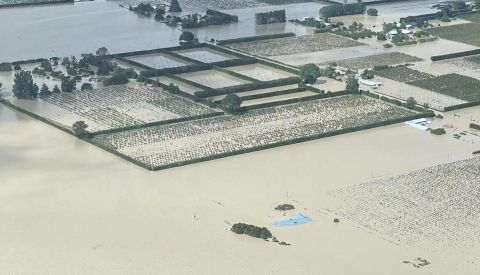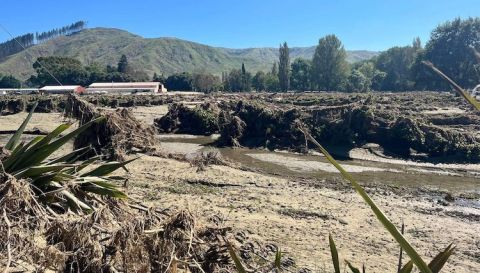Dodging Cyclone Gabrielle

23 February 2023 This week’s free Throwback Thursday article is Jancis’s report yesterday for Purple Pagers on the devastating effects of the recent cyclone in New Zealand.
22 February 2023 Just back from a two-week tour of New Zealand wine country, Jancis could hardly ignore the weather, nor its consequences. Above, the path of Cyclone Gabrielle on 13 February (© OpenStreetMap via Zoom Earth).
Leaving Auckland airport for London on Monday, I couldn’t help noticing what looked like large sacks of flour that someone had left strewn around. Then I realised they were sandbags, acknowledgment of not just one but two successive and extremely scary storms to hit New Zealand’s largest city. The last weekend of January, before I arrived, so much rain fell that the departure lounge ended up several feet deep in water and some Auckland houses literally fell down a cliff thanks to storm-induced erosion.
Auckland airport had to be closed twice in less than a fortnight. The last tourists to arrive there for a holiday in Aotearoa headed for the South Island as fast as they possibly could. Queenstown in Central Otago, the one NZ wine region that seems to have had a trouble-free 2022/23 growing season, ran out of rental cars.
As I started my tour of New Zealand’s North Island wine regions from north to south, everyone was braced for the arrival of a vicious and unpredictable big blob on the weather map called Cyclone Gabrielle. A Minister for Auckland had been hurriedly appointed by the new prime minister in the hope that the city would be better prepared second time round.
On a deceptively calm summer’s morning at The Landing in the Bay of Islands, the director of this stunning wine estate Peter Jones sailed his boat that had been sitting so prettily in the bay round the corner to the local marina, hoping to minimise potential damage to her. The Landing’s viticulturist Tereza Byrne explained, while showing off her carefully tended vines already netted to keep hungry birds off the ripening fruit, that she wouldn’t be bothering to lift the nets before harvest; Gabrielle would do the job for her.
By the time our little group of two Masters of Wine and one Master Sommelier (about to be joined by Nick Ryan, one of Australia’s foremost wine writers) had reached Martinborough in the south of the North Island, Gabrielle was scheduled to hit the east coast just north of us. Steve Smith MW, organiser of our trip under the auspices of the newly formed New Zealand Fine Wine Producers Group, spent the best part of Sunday night finding us a flight to the South Island and we fled early on Monday morning, having spent the Saturday night at his dangerously exposed beach house an hour south of Hawke’s Bay.
By the time we reached the relative safety of Marlborough on Monday, reports were starting to come in of record winds and rainfall in both Gisborne and Hawke’s Bay on the North Island’s east coast. All we suffered was grey skies and a bit of rain in Marlborough but the speed and force with which Gabrielle arrived further north was truly terrifying. As I write the death toll is at least 11 with several hundred people still unaccounted for.
We’d flown into Hastings in Hawke’s Bay on a sunny Friday over the flat expanse of vineyards and, increasingly, orchards bisected by the wide Ngaruroro River. At that stage most rivers were little braided trickles but once Gabrielle hit, the whole area, including Gisborne to the north, which was probably the country’s hardest-hit area, rapidly became a flood plain. The two main rivers, Ngaruroro and Tutaekuri, burst their banks at the same time and the land is now covered in silt with harvest only two or three weeks away.
There were reports of people whose bedrooms filled up with water so fast that the only way they could escape was to dive under the lintel of their submerged bedroom doorway. News channels have shown heart-rending reports of whole communities destroyed.
One immediate effect of a visit from Gabrielle was a loss of power, and for quite some time on the Tuesday and Wednesday those affected in Gisborne and Hawke’s Bay had no means of communication, leaving devastated inhabitants in limbo. Smith, who returned home to Hawke’s Bay on the Monday after dropping us off at Wellington airport for our flight south, caught up with us again in Christchurch on Thursday night and reported that virtually the only news some people got was from the Gisborne Herald, printed twice a day and dropped strategically by helicopter. Gisborne’s main town Napier, all but destroyed in an earthquake in 1931 and subsequently rebuilt, is famous for its art deco architecture. Napier’s Art Deco Festival, a major event in New Zealand, had been due to start on the Thursday as the storm’s predations revealed themselves – see below in this second image courtesy of Sarah Little at Helio Wine, this one of Hawke’s Bay post-Gabrielle.
Smith was a driving force in the formation of the Gimblett Gravels informal appellation in Hawke’s Bay and must be proud that its famously free-draining soils will presumably have saved producers there from the worst. His prediction was that about 80% of Hawke’s Bay vineyards would survive, and may even produce a decent 2023 crop, but he reckoned a good third of the orchards, which tend to be closer to the coast, will have been destroyed, along with 100-year-old oak trees.
Today, Gisborne is still cut off from Hawke’s Bay because all the bridges in between are destroyed, generally by the sheer force of the detritus of logging that the storm washed downriver. There is much talk of the need to force the forestry industry to tidy up after itself – but that is too late for many farmers. And anyway, without road links, how is fruit from north of the rivers to be delivered to the apple stores and wineries of Hawke’s Bay? Julian Grounds of Craggy Range reported no serious damage where they are, well south of the two main rivers, but was concerned that it was impossible to get north to inspect damage there.
Just two days before the storm hit we’d also visited Lorraine Leheny and Warren Gibson at their Bilancia La Colline vineyard atop one of Hawke’s Bay’s relatively few hills so I asked how things were with them. Leheny replied on the Wednesday, ‘There is quite a bit of slip damage in the vineyard. Yesterday we were devastated, today we are pragmatic and working out what we can do long term. In the short term it will be an interesting harvest. There was a lot of rain. The reality though, is what we have suffered is inconsequential in the whole scheme of things. It only affects us. So many people have lost everything. Those mighty Hawke’s Bay rivers proved their strength, breaching all those stop banks we talked about and flooded the plains, and taking bridges with them. Most of the real drama is closer to Napier where the rivers all meet. There was so much rain in the hills and it just needed somewhere to go.’
After the giant Indevin’s 2021 takeover of the Fistonich family’s Villa Maria, one of NZ’s larger wine companies, founder George Fistonich held on to The Terraces vineyards of sister company Esk Valley in Hawke's Bay. A picture of them circulating today shows a mudbath with hardly a vine to be seen. (24 February 2023 I'm assured that the picture must have been of some other vineyard() in the Esk Valley and that The Terraces vineyard is still looking good. See this post, for which I am grateful, in our Members' forum.)
The Gisborne region to the north of Hawke’s Bay, New Zealand’s easternmost, has apparently suffered no fewer than seven ‘extreme weather events’, as they are known, in the last 18 months – and bore the brunt of Cyclone Bola, the worst before Gabrielle, in 1988. It also suffers the ignominy in wine terms of being a feeder region for basic white blends and sparkling wine base rather than being properly celebrated in its own right. Denis Irwin’s Matawhero may have put Gisborne on the wine map in the 1980s (and is currently being resurrected). James and Annie Millton were left to carry the Gisborne torch, being biodynamic pioneers and Chenin Blanc champions, but the estate was put on the market before the storm.
Toby Buck of Te Mata wrote movingly in Lessons from an exile on these pages about how much he was looking forward to returning to the family wine estate in Hawke’s Bay this February after a long, COVID-enforced period in Europe. He sent this picture of a fine old tree felled by Gabrielle and emailed (the winery had internet even if the family home didn’t) that it was ‘upsetting to leave after one crisis and come back just in time for another. We’re just pumping out a cellar, netting vines and straightening posts and end-assemblies. Wild stuff.
‘All the fruit is still looking pretty good for us, though some of it is horizontal. But Esk Valley vines are washed away. Such is the story of winemaking amid climate instability. Warmer seas mean bigger storms. Even though we’re up for it, there are new challenges for fine wine in this part of the world.'
There is certainly no shortage of fine wine in New Zealand and I have enormous faith in the resilience of New Zealanders, which was demonstrated at a farewell dinner for 20 in Marlborough last Wednesday night. Just after we sat down there was a rumble and the glasses on the table started to wobble. We looked at each other. Some of the better-trained round the table were eyeing up how they were going to get under it. Then things calmed down and all the locals opened the country’s earthquake app on their phones. ‘Yes – 5.7!’ was the cry.
The most recent Turkish/Syrian one was 6.4 and very much more serious in its effects, but of course the Richter scale is exponential. We just tucked in to our iced gazpacho.
Those wishing to donate directly to the Hawke’s Bay and Gisborne wine communities can find more information here.
Become a member to view this article and thousands more!
- 15,426 featured articles
- 274,442 wine reviews
- Maps from The World Atlas of Wine, 8th edition (RRP £50)
- The Oxford Companion to Wine, 5th edition (RRP £50)
- Members’ forum
- 15,426 featured articles
- 274,442 wine reviews
- Maps from The World Atlas of Wine, 8th edition (RRP £50)
- The Oxford Companion to Wine, 5th edition (RRP £50)
- Members’ forum
- Commercial use of our Tasting Notes



